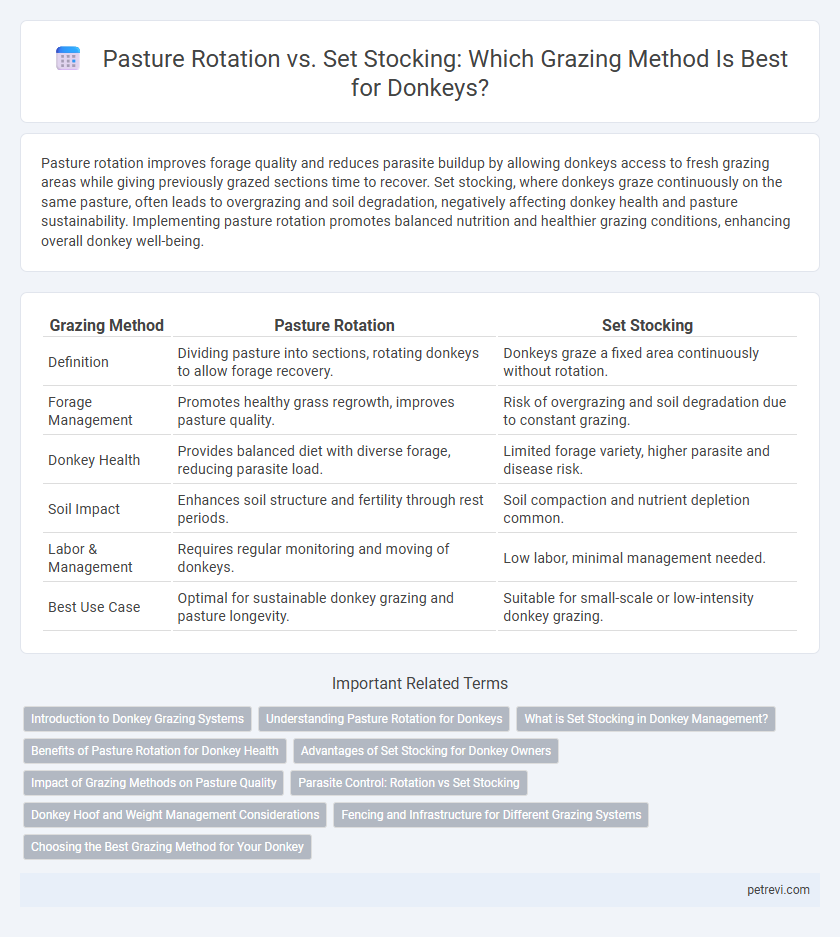Pasture rotation improves forage quality and reduces parasite buildup by allowing donkeys access to fresh grazing areas while giving previously grazed sections time to recover. Set stocking, where donkeys graze continuously on the same pasture, often leads to overgrazing and soil degradation, negatively affecting donkey health and pasture sustainability. Implementing pasture rotation promotes balanced nutrition and healthier grazing conditions, enhancing overall donkey well-being.
Table of Comparison
| Grazing Method | Pasture Rotation | Set Stocking |
|---|---|---|
| Definition | Dividing pasture into sections, rotating donkeys to allow forage recovery. | Donkeys graze a fixed area continuously without rotation. |
| Forage Management | Promotes healthy grass regrowth, improves pasture quality. | Risk of overgrazing and soil degradation due to constant grazing. |
| Donkey Health | Provides balanced diet with diverse forage, reducing parasite load. | Limited forage variety, higher parasite and disease risk. |
| Soil Impact | Enhances soil structure and fertility through rest periods. | Soil compaction and nutrient depletion common. |
| Labor & Management | Requires regular monitoring and moving of donkeys. | Low labor, minimal management needed. |
| Best Use Case | Optimal for sustainable donkey grazing and pasture longevity. | Suitable for small-scale or low-intensity donkey grazing. |
Introduction to Donkey Grazing Systems
Donkey grazing systems benefit significantly from pasture rotation, which promotes better forage regrowth and reduces parasite buildup compared to set stocking. Set stocking often leads to overgrazed pastures, decreasing forage quality and increasing soil erosion risks. Implementing rotational grazing enhances pasture sustainability and improves donkey health through varied diet and reduced exposure to parasites.
Understanding Pasture Rotation for Donkeys
Pasture rotation for donkeys involves dividing grazing land into several sections, allowing each to rest and recover while donkeys graze on another. This method promotes healthier grass growth, reduces overgrazing, and lowers parasite loads, thereby improving donkey health and pasture sustainability. Rotating paddocks every two to three weeks optimizes forage availability and supports efficient nutrient cycling specific to donkey dietary needs.
What is Set Stocking in Donkey Management?
Set stocking in donkey management involves keeping donkeys continuously on the same pasture without rotation, allowing them unrestricted access to the available forage. This method can lead to overgrazing and soil degradation if stocking rates are not carefully managed. Effective set stocking requires monitoring pasture condition and adjusting donkey numbers to prevent land damage and maintain forage availability.
Benefits of Pasture Rotation for Donkey Health
Pasture rotation significantly improves donkey health by preventing overgrazing, which reduces parasite load and enhances forage quality. This method promotes diverse plant growth, supplying donkeys with a balanced diet rich in essential nutrients. Limited exposure to contaminated grazing areas decreases the risk of infections, supporting overall digestive and immune system health in donkeys.
Advantages of Set Stocking for Donkey Owners
Set stocking offers donkey owners simplified management by maintaining consistent access to familiar grazing areas, reducing stress and promoting steady weight maintenance. It minimizes labor requirements compared to pasture rotation, as donkeys remain in one location without the need for frequent fencing adjustments or movement. Consistent forage availability supports digestive health and stable nutrient intake crucial for donkeys' overall well-being.
Impact of Grazing Methods on Pasture Quality
Pasture rotation significantly improves pasture quality for donkeys by promoting even forage consumption and allowing regrowth periods, which enhances soil health and prevents overgrazing. In contrast, set stocking often leads to uneven grazing pressure, resulting in patchy vegetation and reduced forage diversity that can degrade soil structure over time. Implementing rotational grazing maximizes nutrient cycling and sustains robust pasture ecosystems crucial for donkeys' nutrition and overall well-being.
Parasite Control: Rotation vs Set Stocking
Pasture rotation significantly reduces internal parasite loads in donkeys by interrupting parasite life cycles through periodic rest of grazing areas, decreasing larvae ingestion. Set stocking maintains constant grazing pressure on the same pasture, increasing exposure to infective parasite stages and elevating parasite burdens. Strategic pasture rotation combined with fecal egg count monitoring optimizes parasite control and improves donkey health.
Donkey Hoof and Weight Management Considerations
Pasture rotation improves forage quality and reduces overgrazing, promoting healthier hoof conditions and aiding weight management in donkeys by encouraging varied movement. Set stocking often leads to uneven pasture utilization, increasing the risk of hoof problems such as hoof rot and excess weight gain due to limited exercise. Prioritizing rotational grazing ensures balanced nutrition and supports optimal donkey hoof integrity and body condition.
Fencing and Infrastructure for Different Grazing Systems
Effective pasture rotation for donkey grazing requires durable, flexible fencing such as electric or portable panel systems to facilitate frequent paddock shifts and prevent overgrazing. In contrast, set stocking relies on permanent fencing structures like woven wire or high-tensile mesh to contain donkeys within one large grazing area, minimizing maintenance but increasing risk of pasture degradation. Infrastructure considerations include water access points and shelter placement, which must be strategically designed in rotational systems to accommodate movement, while set stocking allows centralized facilities but demands careful pasture management to sustain forage quality.
Choosing the Best Grazing Method for Your Donkey
Pasture rotation enhances forage quality and nutrient intake for donkeys by allowing rest periods that promote regrowth, reducing parasite loads and soil degradation compared to set stocking. Set stocking, where donkeys graze continuously on the same pasture, can lead to overgrazing, decreased forage availability, and increased exposure to parasites. Selecting pasture rotation supports optimal donkey health and pasture sustainability, making it the preferred grazing method for improving digestion and overall well-being.
Pasture Rotation vs Set Stocking for Donkey Grazing Infographic

 petrevi.com
petrevi.com